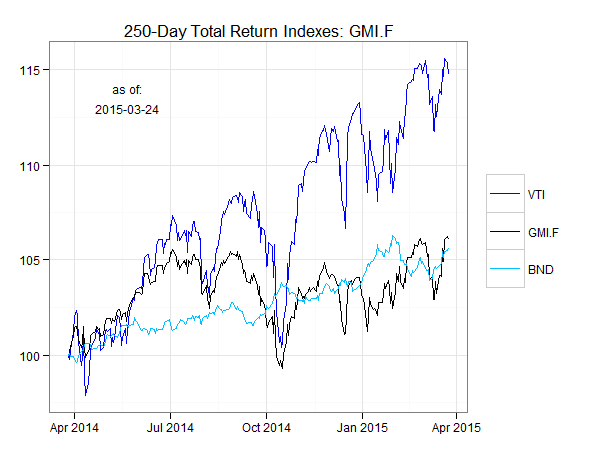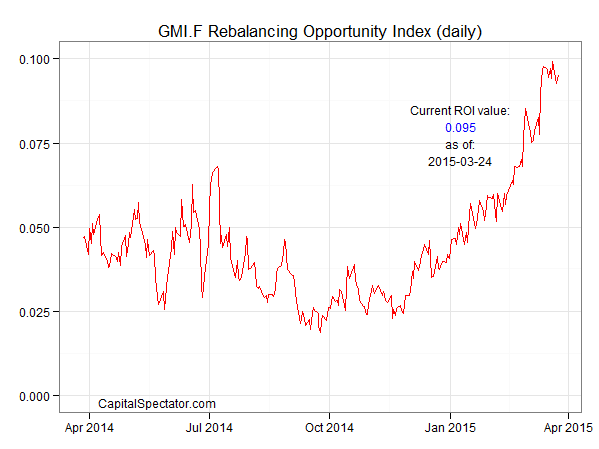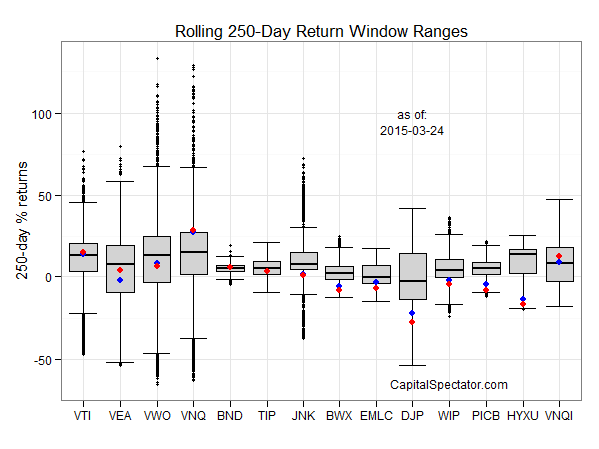US Real estate investment trusts (REITs) are still firmly in the lead among the major asset classes for the trailing one-year period. The Vanguard REIT ETF (ARCA:VNQ) has gained a hefty 28.6% on a total return basis through yesterday (March 24) over the past 250 trading days (aka the one-year performance window). For the moment, no other broadly defined asset group comes close to that red-hot record.
The same is true for commodities — on the flip side. Using our standard list of exchange-traded products as proxies, the iPath Bloomberg Commodity Index ETN (NYSE:DJP) is still dead last over the past 250 trading days, sliding more than 27% through yesterday’s close.

Here’s a graphical recap of the relative performance histories for each of the major asset classes for the past 250 trading days via the ETF proxies. The chart below shows the performance records through Mar. 24, 2015, with all the ETFs rebased to a starting-value of 100. REITs are clearly in the lead by this measure (dark blue line at top of chart below) vs. the rest of the field.
Now let’s review an ETF-based version of an unmanaged, market-value-weighted mix of all the major asset classes — the Global Market Index Fund, or GMI.F, which holds all the ETFs in the table above. Here’s how GMI.F stacks up for the past 250 trading days through March 24, 2015. This investable strategy is ahead by a moderate 6.1% over that span — well below the performance for US stocks (via Vanguard Total Stock Market ETF (ARCA:VTI)) while incrementally higher than the return for US bonds (via Vanguard Total Bond Market ETF(NYSE:BND)) at the moment.

Comparing the median dispersion for 250-day returns for the major asset classes via ETFs suggests that the general rebalancing opportunity has increased sharply for GMI.F vs. recent history. Analyzing the components of GMI.F with a rolling median absolute deviation via one-year returns for the ETFs — the GMI.F Rebalancing Opportunity Index, as it’s labeled on these pages — suggests that there’s enhanced potential for adding value by reweighting this portfolio in comparison with the past year.
Keep in mind that the opportunity for productive rebalancing will vary depending on the choice of holdings and historical time window. Also, don’t overlook the possibility that any given pair of ETFs may present a substantially greater or lesser degree of rebalancing opportunity vs. analyzing GMI.F’s components collectively, which is the methodology that’s reflected in the chart below. Note that the chart focuses on looking backward. If you’re confident in your forecast for risk and return, the ex ante view of rebalancing opportunity may paint a distinctly different outlook vs. an ex post analysis.

Finally, let’s compare the rolling one-year returns for the ETFs in GMI.F via box-plots for a revealing comparison of price momentum. The gray boxes in the chart below reflect the middle range of historical 250-day returns for each ETF — the 25th to 75th return percentiles. The red dots show the current return (through March 24) vs. the 250-day return from 30 trading days earlier (blue dots, which may be hiding behind the red dots in some cases). For instance, the chart shows that REITs (VNQ) continue to hold the lead, as shown by the elevated level of the ETF’s red dot.

